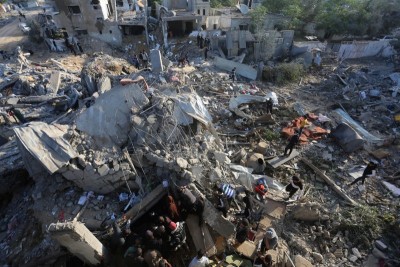Some 22 million displaced by natural disasters in 2013, UN-backed report reveals
The report, Global Estimates 2014: people displaced by disasters, conducted by the Norwegian Refugee Council’s Internal Displacement Monitoring Centre (IDMC), shows that the risk of displacement due to disasters has more than doubled over the last four decades–largely due to the growth and concentration of urban populations, particularly in vulnerable countries.
“This increasing trend will continue as more and more people live and work in hazard-prone areas. It is expected to be aggravated in the future by the impacts of climate change,” said Jan Egeland, Secretary-General of the Norwegian Refugee Council, at a Headquarters conference.
Launching the report alongside Egeland, UN Deputy Secretary-General Jan Eliasson said the report was “extremely timely” as it highlights the need for early warning systems and emergency evacuations in on Wednesday’s world of increasing and intensifying disasters.
“The numbers of people who need humanitarian assistance, and the cost of helping them, are skyrocketing. We need to shift our focus to prevention and preparedness in close cooperation with national partners,” said Eliasson.
The report calls for action to be taken to reduce disaster risk and to help communities adapt to changing and more unpredictable weather patterns, to prevent further displacement.
According to the report, both wealthy and poorer countries are affected, although developing countries bear the brunt, accounting for more than 85 per cent of displacement. But as in previous years the worst affected was Asia, where 19 million people, or 87.1 per cent of the global total, were displaced.
In the Philippines, typhoon Haiyan alone displaced 4.1 million people, a million more than in Africa, the Americas, Europe and Oceania combined.
Seasonal floods also caused significant displacement in sub-Saharan Africa, most notably in Niger, Chad, Sudan and South Sudan – countries with highly vulnerable populations who are also affected by conflict and drought.
Africa’s population is predicted to double by 2050 therefore displacement risk is expected to increase faster than in any other region in the world.
The extent to which populations in the most developed countries are exposed to hazards also led to some of the world’s largest displacements. Typhoon Man-yi in Japan displaced 260,000 people and tornadoes in the United States state of Oklahoma 218,500.
As the world gears up to solidify a post-2015 development agenda, there will also be an opportunity to include the needs and challenges of internally displaced people in negotiations.
“As we prepare for the [Secretary-General’s] climate summit next week the devastating impact of disasters and the massive displacement we see as a result, highlight the need for strong and decisive action to tackle the catastrophic threat of climate change,” Eliasson said.
Support Our Journalism
We cannot do without you.. your contribution supports unbiased journalism
IBNS is not driven by any ism- not wokeism, not racism, not skewed secularism, not hyper right-wing or left liberal ideals, nor by any hardline religious beliefs or hyper nationalism. We want to serve you good old objective news, as they are. We do not judge or preach. We let people decide for themselves. We only try to present factual and well-sourced news.







